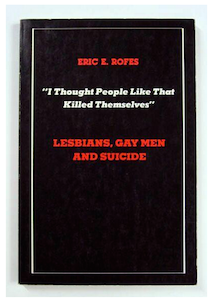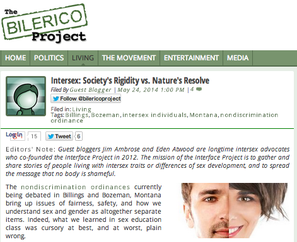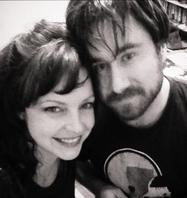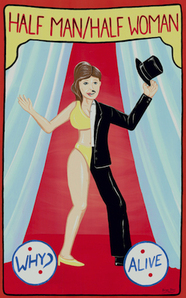I Thought People Like That Were Clip Art
(First appeared in The Interface Project, May 26, 2014)
When I was a college freshman (1994) I read a book analyzing the reality and myth of gay men, lesbians, and suicide: Eric Rofes’ "I Thought People Like That Killed Themselves." The title paraphrases a remark made by King George V of England (circa WWI) when told that someone he knew well was a homosexual. I was aware I still lived in a time when people might reply the same way if they discovered a friend was gay. 20 years later we see what refusing to be unseen and demanding respect and autonomy via activism and accurate portrayals of gay and lesbian lives in journalism, film, and literature has brought more visibility and opportunity to their movement.
On Saturday, May 24, 2014 The Bilerico Project published (yes, they worked on a Saturday) a piece I wrote with the co-founder of The Interface Project, Eden Atwood originally titled Society’s Rigidity vs. Nature’s Resolve: Biology, Assumptions & Nondiscrimination Ordinances in Montana. The piece was composed to encourage the passing of fully inclusive nondiscrimination ordinances in the cities of Billings and Bozeman, Montana. I understand cutting a bio and a title, but what was politically, professionally, and humanistically unacceptable was the choice of photo. The photo we provided was of myself and Eden: the authors, Actual Intersex People. The Bilerico Project chose not to use it. What was chosen was a minstrel-esque/sideshow portrayal of intersex people typical of almost all media: mainstream, gay, queer, what have you.
Actual Intersex People – people born with variations of sex anatomy, or differences of sex development, are not anyone’s cartoonish conception of the romantic and liminal state of gender expression, a cherub caught between, on display at a circus, fantastic, tragic and tortured, etc.
Many intersex people live with grim consequences that are very real, and as far from mythology as you can imagine.
May 24, 2014 reminds me how many times I’ve heard a listener’s honest reaction ("I think I would kill myself") to my description of what routinely happens to intersex babies, or the details of my own childhood.
I live in this time. Today, and right now, editorial choices like these serve only disinformation through titillation, fascination, and confusion. These conscious choices keep people born with variations of sex anatomy invisible and unreal – not unlike a lesbian, or gay man, in Pre-WWI Britain.
Visibility – being truly seen. It isn’t given. It’s demanded, and then it's taken.
—--
#intersex #visibility #humanism #autonomy #selfdetermination #victory
May 24, 2014 reminds me how many times I’ve heard a listener’s honest reaction ("I think I would kill myself") to my description of what routinely happens to intersex babies, or the details of my own childhood.
I live in this time. Today, and right now, editorial choices like these serve only disinformation through titillation, fascination, and confusion. These conscious choices keep people born with variations of sex anatomy invisible and unreal – not unlike a lesbian, or gay man, in Pre-WWI Britain.
Visibility – being truly seen. It isn’t given. It’s demanded, and then it's taken.
—--
#intersex #visibility #humanism #autonomy #selfdetermination #victory




